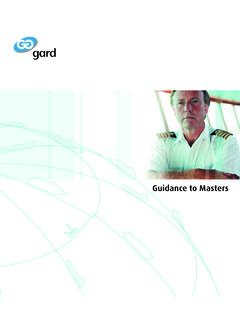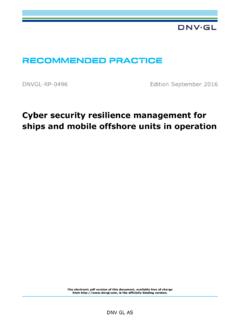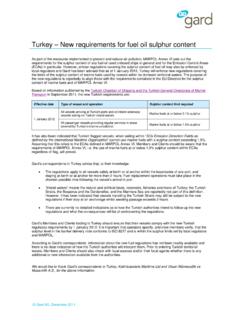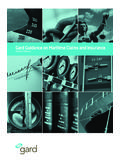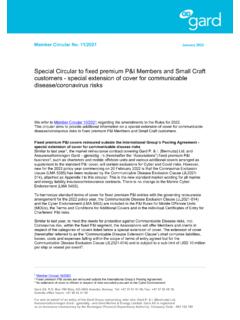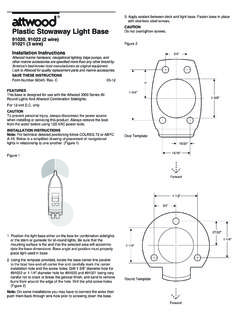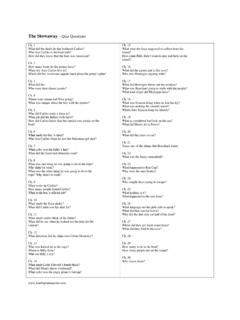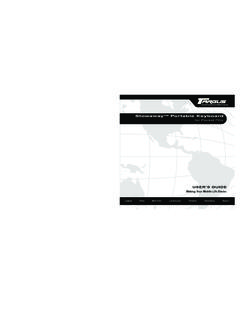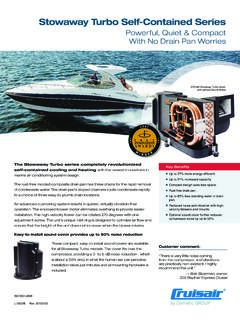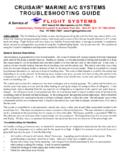Transcription of Gard Guidance on Stowaways
1 Gard Guidance on Stowaways 1 Introduction 4. THE stowaway PROBLEM 4. THE PURPOSE OF THIS Guidance 4. 2 Risk assessment and preventive measures 5. INTRODUCTION 5. GEOGRAPHICAL AREA OF OPERATION 5. Regional hot spots 5. Area statistics 6. VESSELS SURROUNDINGS AND PORT AREA 6. Port security 7. Reducing the risk port area 7. ON BOARD OWN VESSEL 8. Reducing the risk - Physical access 8. Reducing the risk - Access points 8. Reducing the risk Misinformation 9. Degree of readiness 9. Equipment for discovering Stowaways 9. 3 When Stowaways are found on board 11. 4 Repatriation 12. STEPS TO BE TAKEN 12. IDENTIFICATION PAPERS - TRAVEL DOCUMENTS 12. POLITICAL ASYLUM 12. ALTERNATIVE METHODS 13. DIVERTING TO LAND Stowaways 13. THE ROLE OF THE P&I CORRESPONDENT 13. 5 The P&I Cover 15. Legal liability 15. stowaway CLAUSE 15. DIVERSION 15. 6 IMO Regulations on Stowaways 17. AN IMO INITIATIVE 17. PREVENTION OF Stowaways INCIDENTS 17.
2 WHILE ONBOARD 17. DISEMBARKATION 18. RETURN OF Stowaways 18. COSTS AND PENALTIES 18. THE ROLE OF THE FLAG STATE 18. 2. 7 ISPS Code 19. GENERAL 19. CONSEQUENCES OF THE ISPS IMPLEMENTATION 19. 8 Conclusion 20. Appendix A Repatriation Report to the owner/ P&I club/ Agent 21. Appendix B Guidance to Masters 22. Appendix C - stowaway Questionnaire for onboard interrogation purposes 24. appendix d - First notice - stowaway claim 26. Appendix E - IMO stowaway Guidelines 27. Gard Guidance on Stowaways 3. Part 1 - Introduction 1 Introduction THE stowaway PROBLEM. Stowaways seem to be an ever-present problem for the shipping industry, in particular to those trading on the coast of West Africa, in Central America, Colombia, Venezuela and on the Dominican Republic. In addition to vessels' trade patterns, this problem is also closely linked to vessel and/or cargo type, as well as to the security training and awareness of the crew.
3 The lion share of Stowaways is found on board bulk, container and general cargo vessels. Car carriers are also over-represented compared to other vessel types. The costs involved in looking after and repatriating Stowaways can be substantial. The repatriation of Stowaways generally involves moving reluctant people across several continents and problems can easily occur. In 2002. the average cost to Gard of each stowaway case was approximately USD 7,000. By 2008 this figure had increased significantly, to just over USD 18,000. These numbers do not include the applicable deductibles paid by the Member and the actual costs are therefore significantly higher. If more than one stowaway gain access to the vessel, the costs have been known to escalate to USD 100,000 or more, simply because repatriation is usually only permitted with two security guards escorting each stowaway . THE PURPOSE OF THIS Guidance .
4 The purpose of this Guidance is to act as a practical reference guide and to assist the Master in avoiding pitfalls and problems when it comes to Stowaways . It is hoped that readers other than the Master will also find this Guidance useful. This Guidance is not intended as a comprehensive reference work or to replace any company specific Guidance . This Guidance is based on articles previously published in Gard News, and is to be used for Guidance purposes only. The Guidance to Masters, 2nd edition, provides a list of actions to be taken and evidence to be collected, as well as a questionnaire to assist the crew, when a stowaway is discovered on board the vessel. The stowaway questionnaire is available in English in this publication and is also available in Portuguese, Spanish, French and Swahili upon request. The section dealing with Stowaways in the Guidance to Masters is reproduced in Appendix B Guidance to Masters, see page 1.
5 The Guidance to Masters can also be found on our website; We hope users will find this Guidance to be both practical and solution oriented, and that our Members and clients as well as their Masters find this information useful. Please also bear in mind that Gard should be contacted immediately upon the discovery of Stowaways on board. All Stowaways can be successfully disembarked eventually. Crew members are advised to be patient and co-operative and, by working as a team, the crew, shipowners, correspondents and the Club can together resolve each stowaway incident. 4. Part 2 - Risk assessment and preventive measures 2 Risk assessment and preventive measures INTRODUCTION. Shipowners and Masters face the problem of identifying the presence of Stowaways before a ship leaves port or preventing their boarding the vessel in the first place. However, most Stowaways are only discovered once a vessel has sailed.
6 Dealing with an incident involves the Master and owner in time-consuming negotiations with club, agents and authorities. The cost alone from disruptions to the ship's schedule alone can be considerable. There are a number of preventive measures the Master and crew can take before the ship enters port, during the stay in port and after departure. Therefore a thorough risk assessment should be considered, identifying the potential hazards present in the ship's area of operation (chapter ), the physical surroundings of the ship upon loading/ discharging (chapter ) and potential hazards present onboard the ship (chapter ). GEOGRAPHICAL AREA OF OPERATION. The following can serve as a reminder to the Master when trading in areas where Stowaways are a common problem: Gather information from all available sources, the shipowner, agents, maritime journals and newspapers, concerning the current status of the stowaway problem in the area.
7 Is this a regional hotspot for Stowaways ? What are the statistics for this area of operation when it comes to Stowaways ? Ascertain the techniques used by Stowaways to gain access to the vessel, bribery, in containers, use boats or swim to hide in rudder trunks, or by posing as stevedores. Discuss the procedures with other Masters to determine effective countermeasures and to gather more intelligence. Regional hot spots The Master should always be aware of regional hot spots for Stowaways and put in place measures to prevent Stowaways gaining access to the ship when operating in high risk areas. Their reasons for stowing away may vary, political, economic, criminal or adventure seeking and it is therefore difficult to Number of Stowaways by nationality Figure 1 Number of Stowaways per nationality, top ten (2007) Figures from the International Group Personal Injury Sub-Committee 2008.
8 Gard Guidance on Stowaways 5. Part 2 - Risk assessment and preventive measures Ports of embarkation Figure 2 Ports of embarkation, top ten (2007). Figures from the International Group Personal Injury Sub-Committee 2008. accurately predict which ports are considered particularly high risk at any given time. There are certain geographical areas which generally are high risk. These include all of Africa, parts of Central America, Venezuela, Colombia and the Dominican Republic. These areas will probably continue to be high-risk for the near future. Gard can be contacted for more detailed information on high risk areas. Masters and crew should be particularly vigilant and focus on measures to prevent Stowaways when calling at ports in these areas. Area statistics Gard has recently seen an increase in the number of reported stowaway incidents. In general the numbers of Stowaways are shown inFigure 1 below which sets out the top ten nationalities of Stowaways .
9 As can be noted the table is dominated by African countries together with Afghanistan and the Dominican Republic. The ports of embarkation are shown in Figure 2. Please note that many Stowaways migrate to other countries before boarding vessels, on the west coast of Africa, Nigerian and Ghanaian Stowaways often leave their homelands before boarding vessels. This is a result of weather conditions, human migration and an ongoing relationship with the drug trade. VESSELS SURROUNDINGS AND PORT AREA. Normally the shipowner has little or no influence on port security and has to concentrate on preventing Stowaways from gaining access to the ship. Stowaways are typically able to gain access to the ship due to inadequate security and/or watch keeping, or are hidden in containers which are subsequently loaded on board, while these are at the terminal. As far as security and watch keeping inadequacy are concerned, a number of measures can be taken depending on the potential risk of Stowaways in the particular port.
10 The core strategy is to ensure that no unauthorised personnel are able to gain access to the ship, and that all those who have been authorised to board disembark before sailing. Given the pressure often put on watchmen, the best solution is to have 6. Part 2 - Risk assessment and preventive measures two watch keepers at each entrance. However, with the small numbers of crew serving on modern ships this is usually not a feasible alternative, the choice being either to recruit local guards, or to arrange for the temporary attachment to the ship of a professional maritime security officer. Engaging guards and/or a maritime security officer may seem extravagant. However, if the threat is considerable the costs involved could well be justified. Repatriation of Stowaways generally involves moving reluctant people across different continents and problems can easily arise. As mentioned above, Stowaways also gain access to ships by hiding in containers, cars or other types of cargo units subsequently loaded on board.
